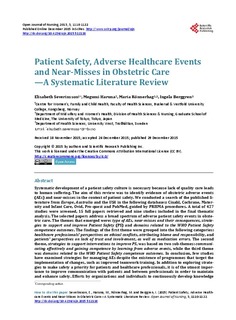| dc.description.abstract | Systematic development of a patient safety culture is necessary because lack of quality care leadsto human suffering. The aim of this review was to identify evidence of obstetric adverse events(AEs) and near-misses in the context of patient safety. We conducted a search of the published literature from Europe, Australia and the USA in the following databases: Cinahl, Cochrane, Maternity and Infant Care, Ovid, Pro-quest and PubMed, guided by PRISMA procedures. A total of 427 studies were screened, 15 full papers retrieved and nine studies included in the final thematic analysis. The selected papers address a broad spectrum of adverse patient safety events in obstetric care. The themes that emerged were: type of AEs, near-misses and their consequences, strategies to support and improve Patient Safety (PS) and domains related to the WHO Patient Safety competence outcomes. The findings of the first theme were grouped into the following categories: healthcare professionals’ perspectives on ethical conflicts, attributing blame and responsibility, and patients’ perspectives on lack of trust and involvement, as well as medication errors. The second theme, strategies to support interventions to improve PS, was based on two sub-themes: communicating effectively and gaining competence by learning from adverse events, while the third theme was domains related to the WHO Patient Safety competence outcomes. In conclusion, few studies have examined strategies for managing AEs despite the existence of programmes that target the implementation of changes, such as improved teamwork training. In addition to exploring strategies to make safety a priority for patients and healthcare professionals, it is of the utmost importance to improve communication with patients and between professionals in order to maintain and enhance safety. Efforts by organizations and individuals to continuously develop knowledge about the risk of AEs and the use of best practice guidelines are also essential. | |
